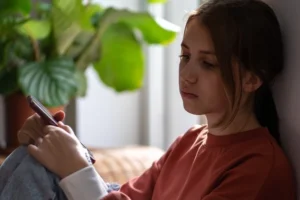The move to senior school involved the children getting public buses, finding the right stop and getting to school on time – all things that had the potential to go wrong. “For me, I felt the phone was so important,” Ali explains. “There have been occasions where they missed the bus after school, and I needed to go and collect them.”
Staying in touch on the move
To begin with, Ali put family numbers into the kids’ phones, and set parental blocks to ensure they couldn’t download apps without entering a code that only Ali knew. “At first, it was just a case of ensuring they could contact me, their Dad or grandparents in an emergency.”
At 13 and 17, both children take phones to school and use them to keep Ali informed if they miss the bus, or if their lunch accounts need topping up. But over time, they’ve become used for other things.
School rules on phones
“There is a rule they’re not allowed to use them without permission from a teacher, but I don’t think it’s enforced,” Ali says. “Both boys have called and Facebook messaged me from school – they know where to go so they don’t get caught.”
Peer pressure to have the latest phones
So far, the biggest issue has been peer pressure around which phone to have. In the early days, both children were given basic phones for calls and texting, but peer pressure meant they soon wanted “better” phones like the ones their friends had. There have also been a few occasions where phones have been lost or broken after being messed around with.
“My son initially had an iPhone but he smashed two screens in two months, so for the rest of the year, I gave him a cheap Android handset, and he got a new phone for his birthday,” says Ali.
Today, both boys have contracts and Ali confesses that she does worry about being stuck paying a monthly fee for something they can’t use, if the handsets get broken. To protect against this, Ali pays for insurance for both phones, and there are limits on both phones to ensure the boys can’t run up large bills.
Biggest worry – online bullying on social
Apart from the expense of new phones, Ali says her biggest worry has been bullying and allowing the kids to be on social media. Overall, though, the benefits outweigh the concerns. “We live in a small village and my youngest son doesn’t have many friends his age here. I think without his phone, he’d be very isolated,” Ali says. “I hear him laughing and joking with his friends on his phone, and it’s nice to see he’s not missing out.”
At 13, Ali does monitor her younger son more closely on social media. “I do worry that he has too much free rein. I checked that he’d removed location tagging on his Snapchat, but I think to an extent, I need to trust him and respect his privacy,” she says.
There is some monitoring of messages since they’re copied to the family iPad, and Ali says her older son does tend to keep an eye on his brother’s activity online. “He will tend to let me know if there’s anything I should now about.”
Trusting kids to make smart choices online
Both boys are expected to turn off devices at 10pm (bedtime) and Ali trusts them to follow the rules. By trusting them, she hopes that they feel able to communicate with her if they are worried or upset by something.
“The best I can do is keep up with news reports about new things in the digital world,” says Ali. “I do ask if I hear they’re chatting with someone whose name I don’t recognize, but I’m always trying to balance them talking to me, with having their secrets. It’s a constant balancing act.”





